FORD TRANSIT 2006 7.G Body And Equipment Mounting Section Manual
Manufacturer: FORD, Model Year: 2006, Model line: TRANSIT, Model: FORD TRANSIT 2006 7.GPages: 234, PDF Size: 33.19 MB
Page 221 of 234
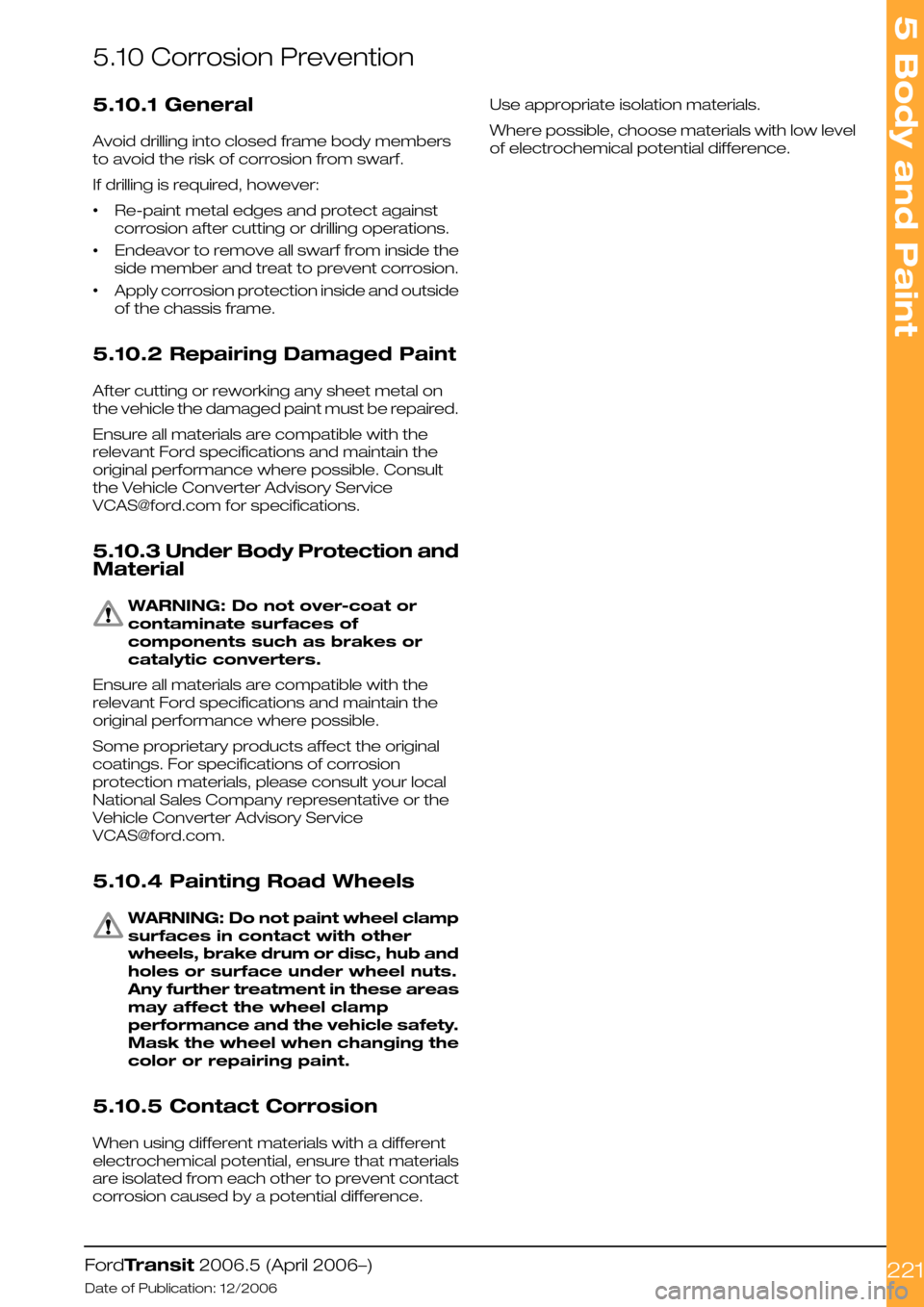
5.10 Corrosion Prevention
5.10.1 General
Avoid drilling into closed frame body members
to avoid the risk of corrosion from swarf.
If drilling is required, however:
•Re-paint metal edges and protect against
corrosion after cutting or drilling operations.
•Endeavor to remove all swarf from inside the
side member and treat to prevent corrosion.
•Apply corrosion protection inside and outside
of the chassis frame.
5.10.2 Repairing Damaged Paint
After cutting or reworking any sheet metal on
the vehicle the damaged paint must be repaired.
Ensure all materials are compatible with the
relevant Ford specifications and maintain the
original performance where possible. Consult
the Vehicle Converter Advisory Service
[email protected] for specifications.
5.10.3 Under Body Protection and
Material
WARNING: Do not over-coat or
contaminate surfaces of
components such as brakes or
catalytic converters.
Ensure all materials are compatible with the
relevant Ford specifications and maintain the
original performance where possible.
Some proprietary products affect the original
coatings. For specifications of corrosion
protection materials, please consult your local
National Sales Company representative or the
Vehicle Converter Advisory Service
[email protected].
5.10.4 Painting Road Wheels
WARNING: Do not paint wheel clamp
surfaces in contact with other
wheels, brake drum or disc, hub and
holes or surface under wheel nuts.
Any further treatment in these areas
may affect the wheel clamp
performance and the vehicle safety.
Mask the wheel when changing the
color or repairing paint.
5.10.5 Contact Corrosion
When using different materials with a different
electrochemical potential, ensure that materials
are isolated from each other to prevent contact
corrosion caused by a potential difference.
Use appropriate isolation materials.
Where possible, choose materials with low level
of electrochemical potential difference.
FordTransit 2006.5 (April 2006–)
Date of Publication: 12/2006
5 Body and Paint
221
Page 222 of 234
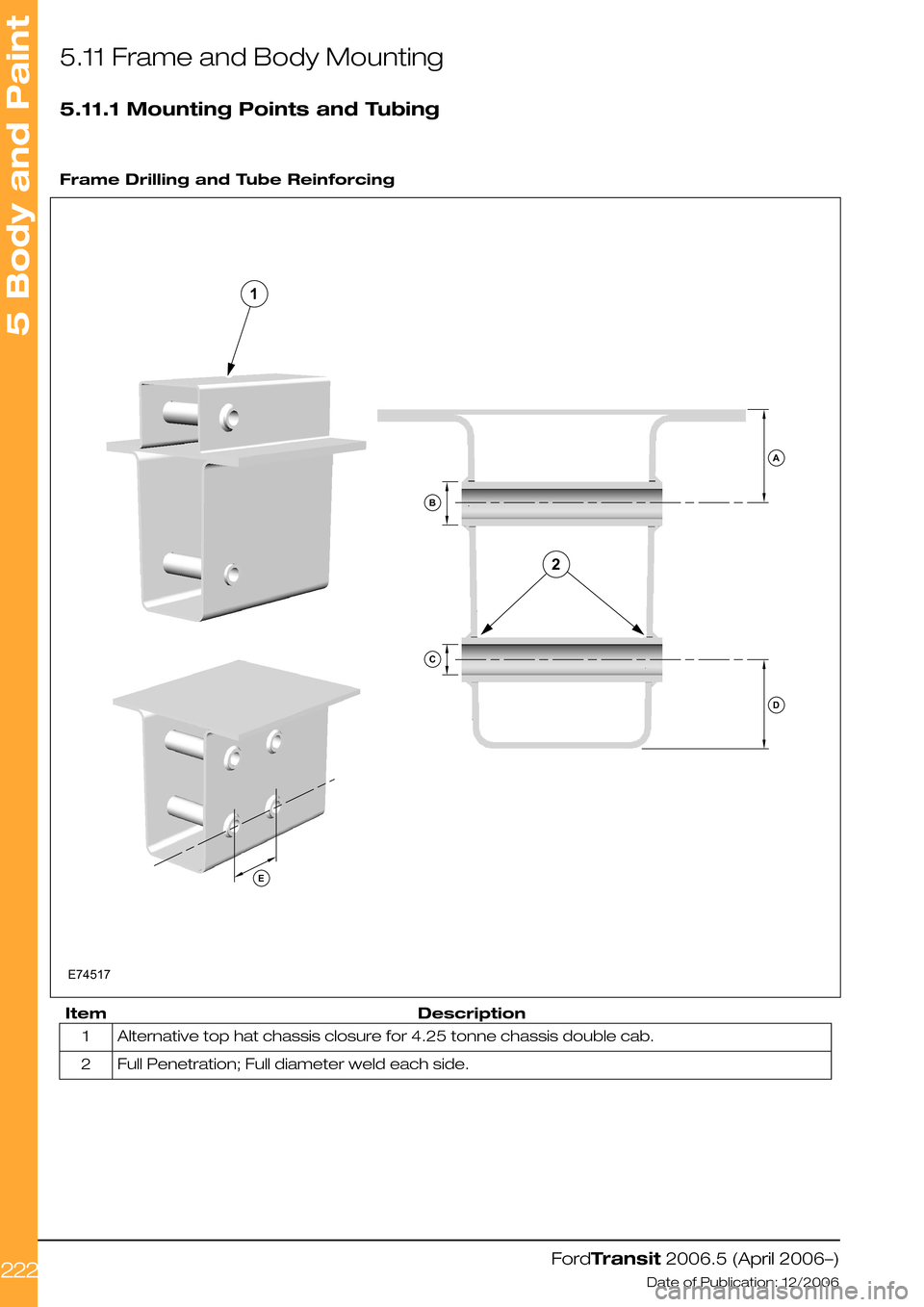
5.11 Frame and Body Mounting
5.11.1 Mounting Points and Tubing
Frame Drilling and Tube Reinforcing
DescriptionItem
Alternative top hat chassis closure for 4.25 tonne chassis double cab.1
Full Penetration; Full diameter weld each side.2
FordTransit 2006.5 (April 2006–)
Date of Publication: 12/2006
5 Body and Paint
222E7451712ABCDE
Page 223 of 234
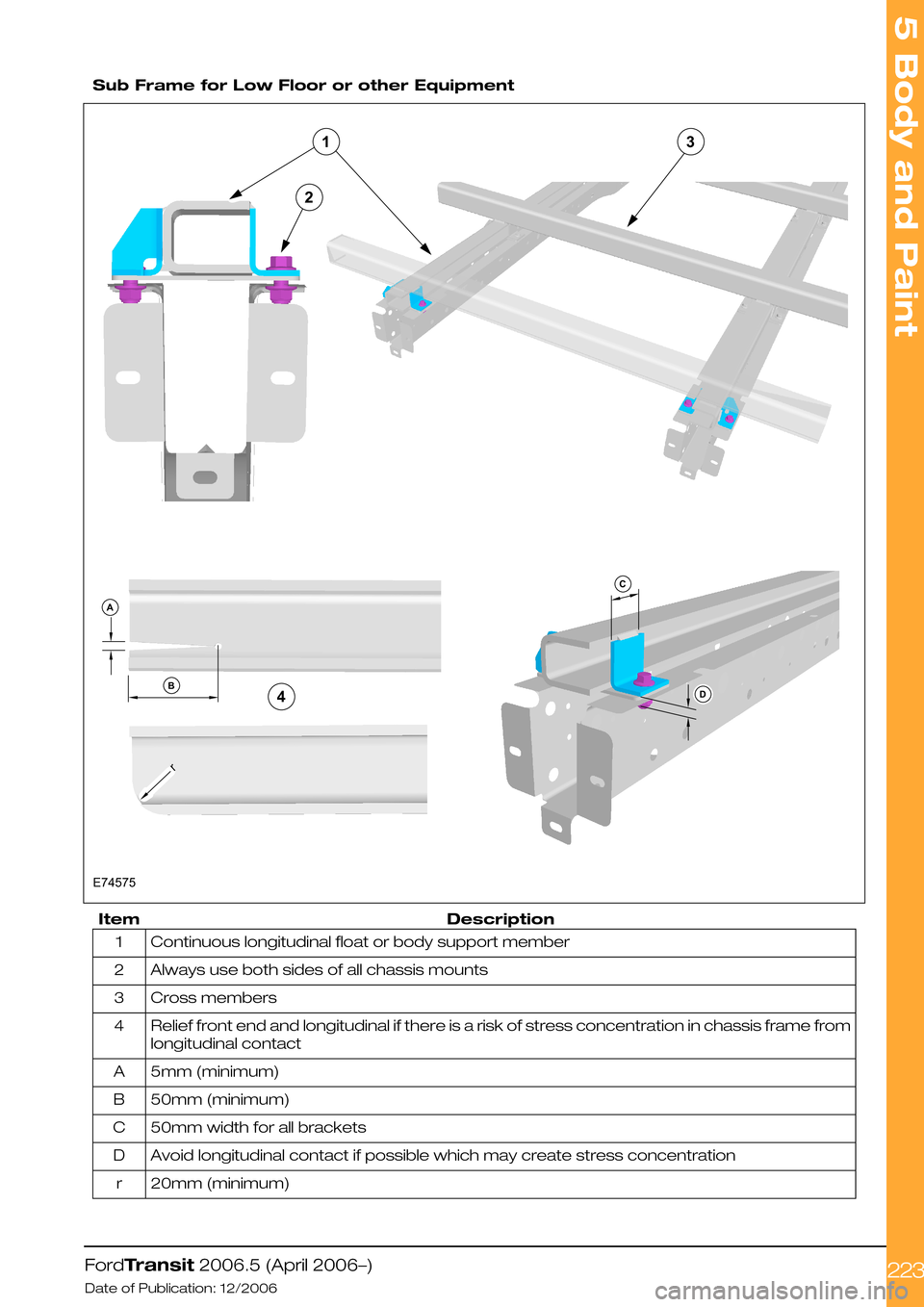
Sub Frame for Low Floor or other Equipment
DescriptionItem
Continuous longitudinal float or body support member1
Always use both sides of all chassis mounts2
Cross members3
Relief front end and longitudinal if there is a risk of stress concentration in chassis frame from
longitudinal contact
4
5mm (minimum)A
50mm (minimum)B
50mm width for all bracketsC
Avoid longitudinal contact if possible which may create stress concentrationD
20mm (minimum)r
FordTransit 2006.5 (April 2006–)
Date of Publication: 12/2006
5 Body and Paint
223E74575rABCD4132
Page 224 of 234
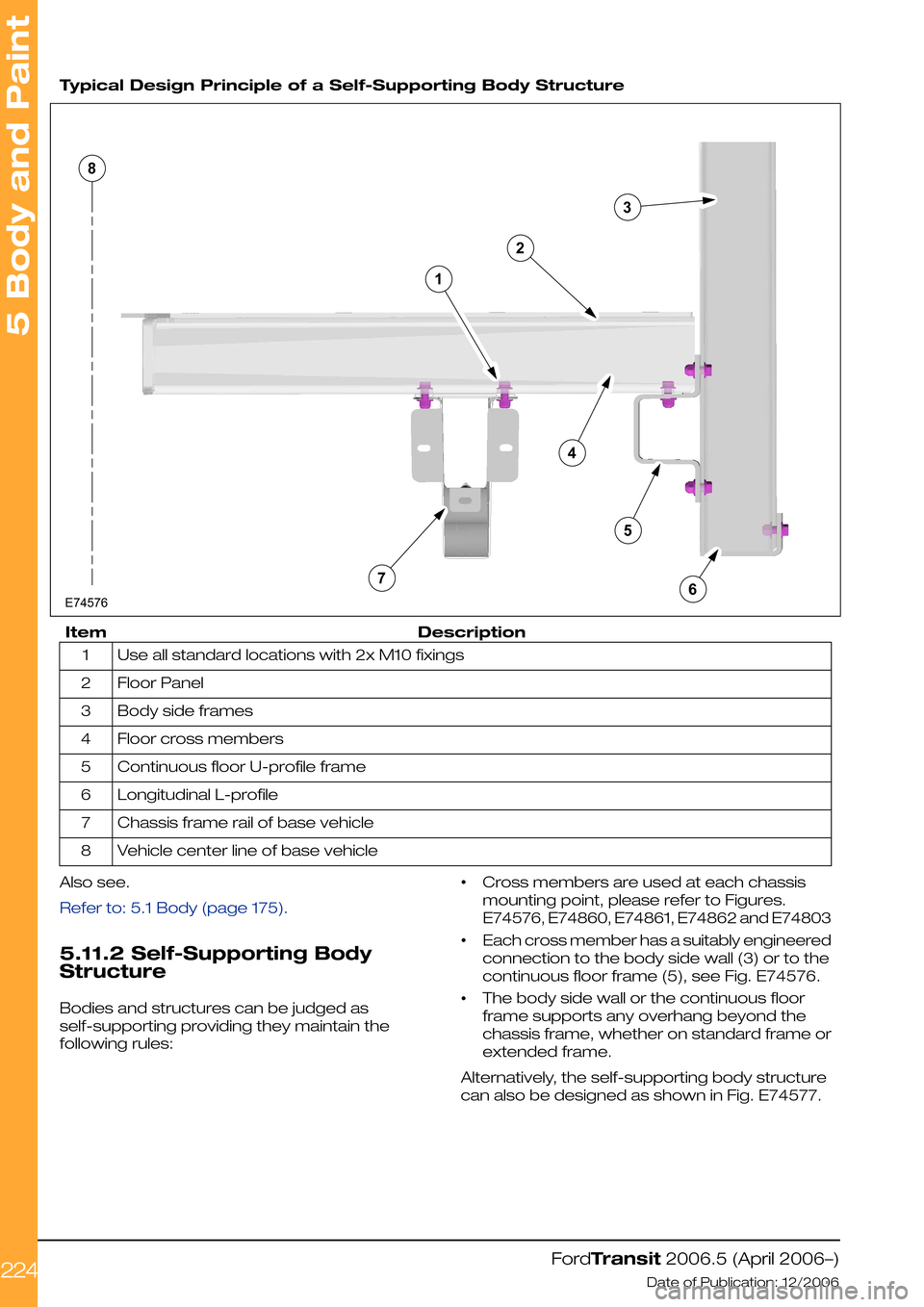
Typical Design Principle of a Self-Supporting Body Structure
DescriptionItem
Use all standard locations with 2x M10 fixings1
Floor Panel2
Body side frames3
Floor cross members4
Continuous floor U-profile frame5
Longitudinal L-profile6
Chassis frame rail of base vehicle7
Vehicle center line of base vehicle8
Also see.
Refer to: 5.1 Body (page 175).
5.11.2 Self-Supporting Body
Structure
Bodies and structures can be judged as
self-supporting providing they maintain the
following rules:
•Cross members are used at each chassis
mounting point, please refer to Figures.
E74576, E74860, E74861, E74862 and E74803
•Each cross member has a suitably engineered
connection to the body side wall (3) or to the
continuous floor frame (5), see Fig. E74576.
•The body side wall or the continuous floor
frame supports any overhang beyond the
chassis frame, whether on standard frame or
extended frame.
Alternatively, the self-supporting body structure
can also be designed as shown in Fig. E74577.
FordTransit 2006.5 (April 2006–)
Date of Publication: 12/2006
5 Body and Paint
224E7457612345678
Page 225 of 234
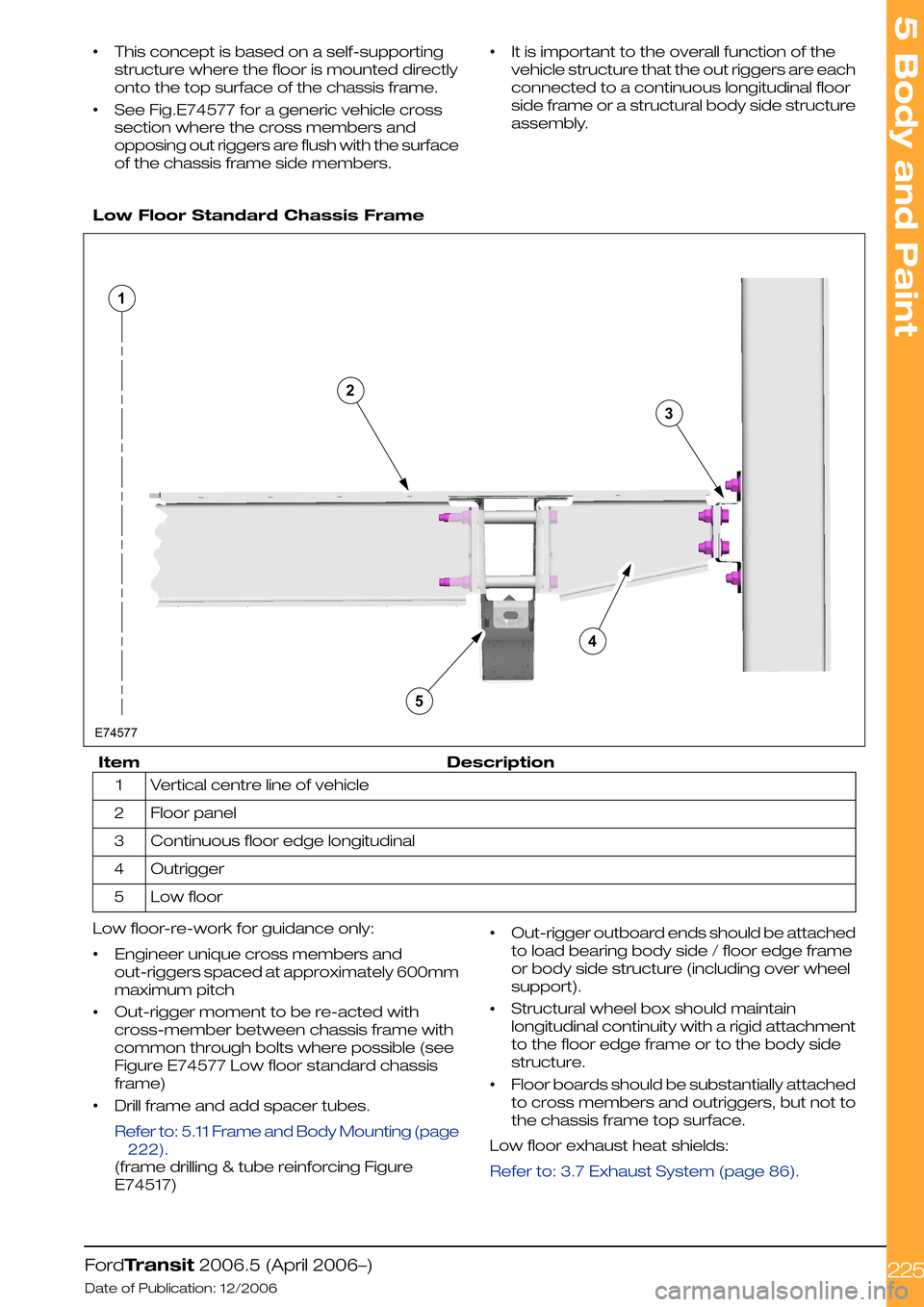
•This concept is based on a self-supporting
structure where the floor is mounted directly
onto the top surface of the chassis frame.
•See Fig.E74577 for a generic vehicle cross
section where the cross members and
opposing out riggers are flush with the surface
of the chassis frame side members.
•It is important to the overall function of the
vehicle structure that the out riggers are each
connected to a continuous longitudinal floor
side frame or a structural body side structure
assembly.
Low Floor Standard Chassis Frame
DescriptionItem
Vertical centre line of vehicle1
Floor panel2
Continuous floor edge longitudinal3
Outrigger4
Low floor5
Low floor-re-work for guidance only:
•Engineer unique cross members and
out-riggers spaced at approximately 600mm
maximum pitch
•Out-rigger moment to be re-acted with
cross-member between chassis frame with
common through bolts where possible (see
Figure E74577 Low floor standard chassis
frame)
•Drill frame and add spacer tubes.
Refer to: 5.11 Frame and Body Mounting (page
222).
(frame drilling & tube reinforcing Figure
E74517)
•Out-rigger outboard ends should be attached
to load bearing body side / floor edge frame
or body side structure (including over wheel
support).
•Structural wheel box should maintain
longitudinal continuity with a rigid attachment
to the floor edge frame or to the body side
structure.
•Floor boards should be substantially attached
to cross members and outriggers, but not to
the chassis frame top surface.
Low floor exhaust heat shields:
Refer to: 3.7 Exhaust System (page 86).
FordTransit 2006.5 (April 2006–)
Date of Publication: 12/2006
5 Body and Paint
225E7457723451
Page 226 of 234
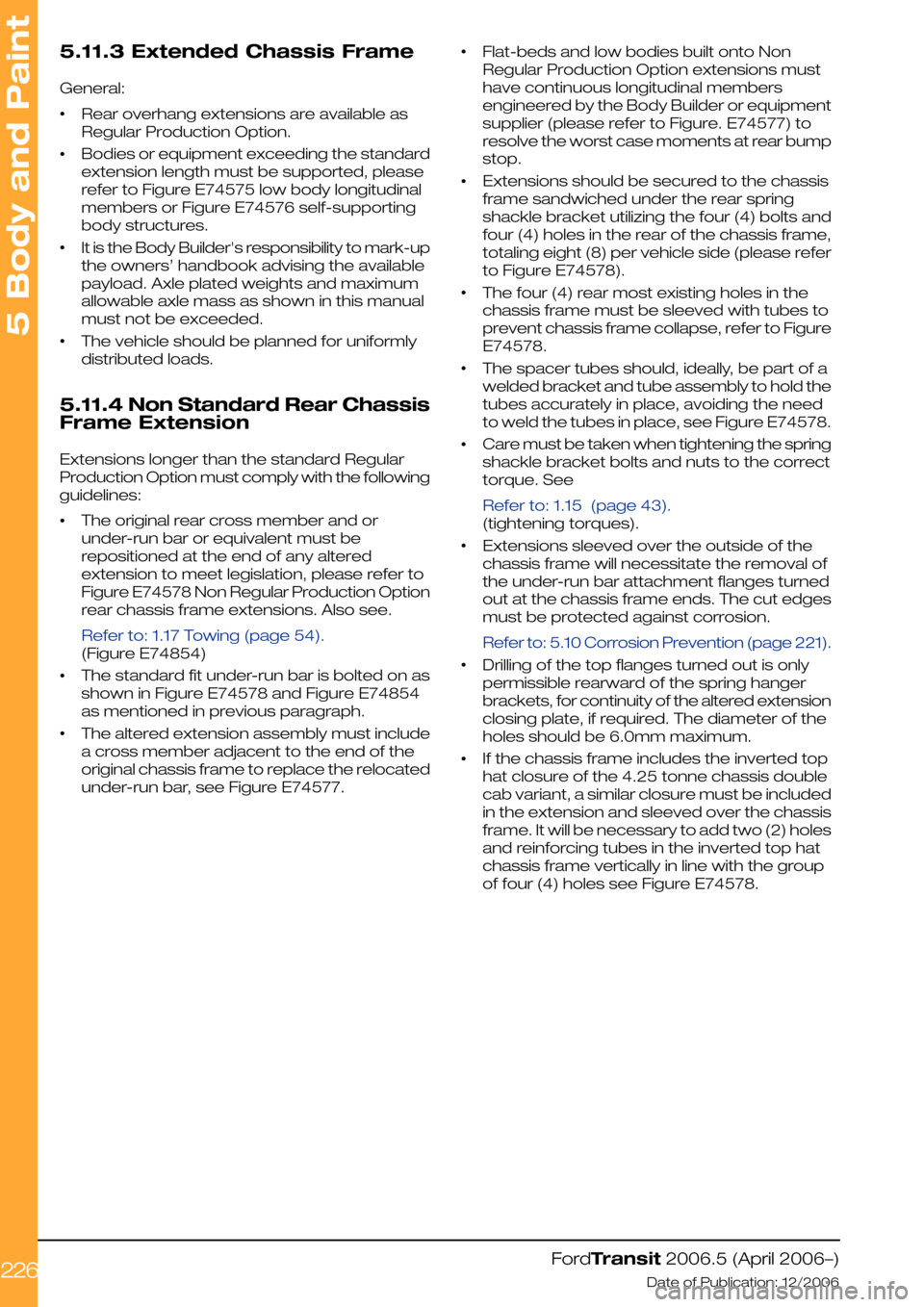
5.11.3 Extended Chassis Frame
General:
•Rear overhang extensions are available as
Regular Production Option.
•Bodies or equipment exceeding the standard
extension length must be supported, please
refer to Figure E74575 low body longitudinal
members or Figure E74576 self-supporting
body structures.
•It is the Body Builder's responsibility to mark-up
the owners’ handbook advising the available
payload. Axle plated weights and maximum
allowable axle mass as shown in this manual
must not be exceeded.
•The vehicle should be planned for uniformly
distributed loads.
5.11.4 Non Standard Rear Chassis
Frame Extension
Extensions longer than the standard Regular
Production Option must comply with the following
guidelines:
•The original rear cross member and or
under-run bar or equivalent must be
repositioned at the end of any altered
extension to meet legislation, please refer to
Figure E74578 Non Regular Production Option
rear chassis frame extensions. Also see.
Refer to: 1.17 Towing (page 54).
(Figure E74854)
•The standard fit under-run bar is bolted on as
shown in Figure E74578 and Figure E74854
as mentioned in previous paragraph.
•The altered extension assembly must include
a cross member adjacent to the end of the
original chassis frame to replace the relocated
under-run bar, see Figure E74577.
•Flat-beds and low bodies built onto Non
Regular Production Option extensions must
have continuous longitudinal members
engineered by the Body Builder or equipment
supplier (please refer to Figure. E74577) to
resolve the worst case moments at rear bump
stop.
•Extensions should be secured to the chassis
frame sandwiched under the rear spring
shackle bracket utilizing the four (4) bolts and
four (4) holes in the rear of the chassis frame,
totaling eight (8) per vehicle side (please refer
to Figure E74578).
•The four (4) rear most existing holes in the
chassis frame must be sleeved with tubes to
prevent chassis frame collapse, refer to Figure
E74578.
•The spacer tubes should, ideally, be part of a
welded bracket and tube assembly to hold the
tubes accurately in place, avoiding the need
to weld the tubes in place, see Figure E74578.
•Care must be taken when tightening the spring
shackle bracket bolts and nuts to the correct
torque. See
Refer to: 1.15 (page 43).
(tightening torques).
•Extensions sleeved over the outside of the
chassis frame will necessitate the removal of
the under-run bar attachment flanges turned
out at the chassis frame ends. The cut edges
must be protected against corrosion.
Refer to: 5.10 Corrosion Prevention (page 221).
•Drilling of the top flanges turned out is only
permissible rearward of the spring hanger
brackets, for continuity of the altered extension
closing plate, if required. The diameter of the
holes should be 6.0mm maximum.
•If the chassis frame includes the inverted top
hat closure of the 4.25 tonne chassis double
cab variant, a similar closure must be included
in the extension and sleeved over the chassis
frame. It will be necessary to add two (2) holes
and reinforcing tubes in the inverted top hat
chassis frame vertically in line with the group
of four (4) holes see Figure E74578.
FordTransit 2006.5 (April 2006–)
Date of Publication: 12/2006
5 Body and Paint
226
Page 227 of 234

Non Standard Chassis Frame Extension
DescriptionItem
Cross member1
Rear spring hanger2
4x M10 bolts3
Spacer tube assembly4
Flanges removed5
New flanges for under-run bar6
2x M10 bolts7
Spacer tube assembly8
4.25 tonne9
FordTransit 2006.5 (April 2006–)
Date of Publication: 12/2006
5 Body and Paint
227E745781257869334
Page 228 of 234
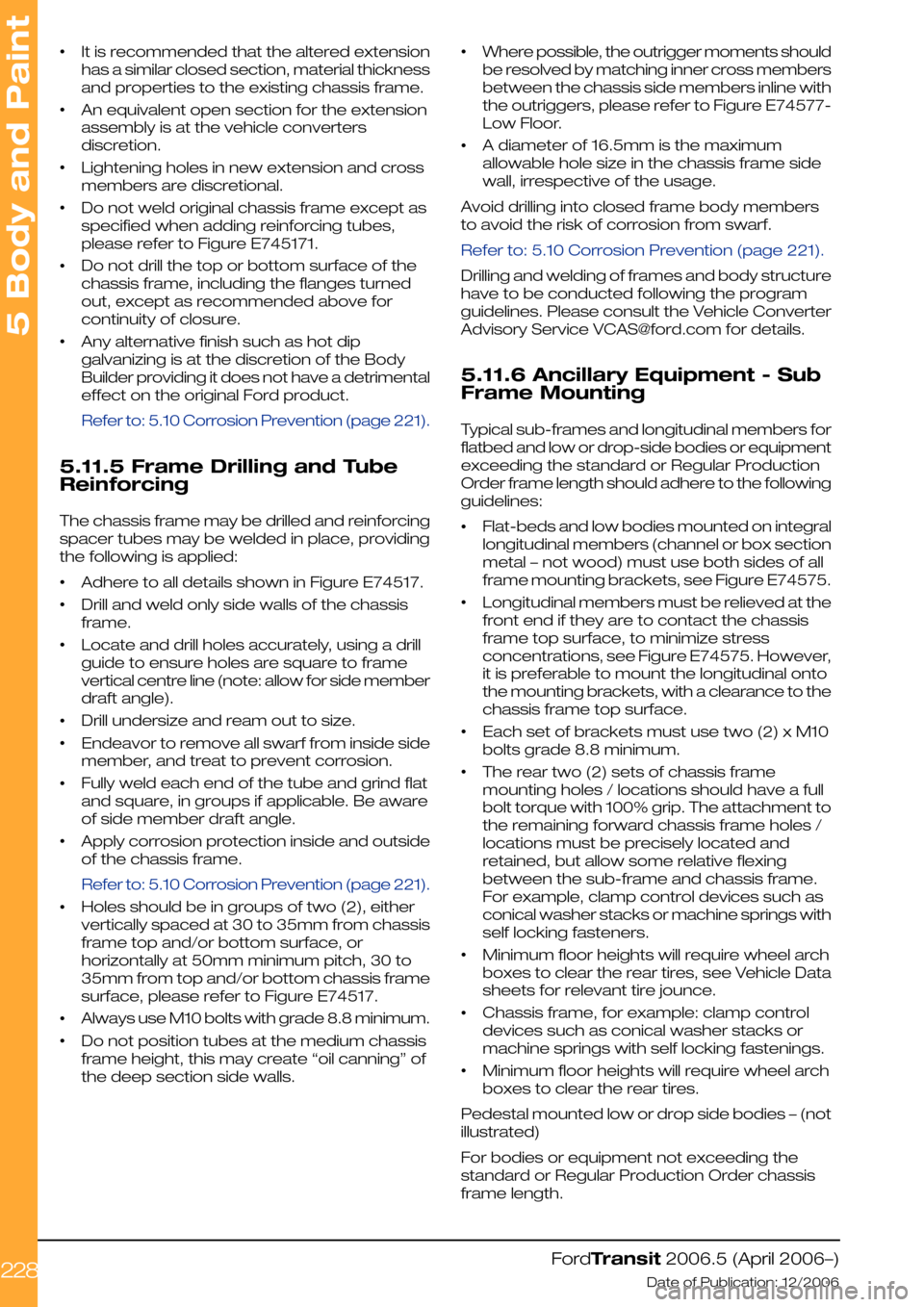
•It is recommended that the altered extension
has a similar closed section, material thickness
and properties to the existing chassis frame.
•An equivalent open section for the extension
assembly is at the vehicle converters
discretion.
•Lightening holes in new extension and cross
members are discretional.
•Do not weld original chassis frame except as
specified when adding reinforcing tubes,
please refer to Figure E745171.
•Do not drill the top or bottom surface of the
chassis frame, including the flanges turned
out, except as recommended above for
continuity of closure.
•Any alternative finish such as hot dip
galvanizing is at the discretion of the Body
Builder providing it does not have a detrimental
effect on the original Ford product.
Refer to: 5.10 Corrosion Prevention (page 221).
5.11.5 Frame Drilling and Tube
Reinforcing
The chassis frame may be drilled and reinforcing
spacer tubes may be welded in place, providing
the following is applied:
•Adhere to all details shown in Figure E74517.
•Drill and weld only side walls of the chassis
frame.
•Locate and drill holes accurately, using a drill
guide to ensure holes are square to frame
vertical centre line (note: allow for side member
draft angle).
•Drill undersize and ream out to size.
•Endeavor to remove all swarf from inside side
member, and treat to prevent corrosion.
•Fully weld each end of the tube and grind flat
and square, in groups if applicable. Be aware
of side member draft angle.
•Apply corrosion protection inside and outside
of the chassis frame.
Refer to: 5.10 Corrosion Prevention (page 221).
•Holes should be in groups of two (2), either
vertically spaced at 30 to 35mm from chassis
frame top and/or bottom surface, or
horizontally at 50mm minimum pitch, 30 to
35mm from top and/or bottom chassis frame
surface, please refer to Figure E74517.
•Always use M10 bolts with grade 8.8 minimum.
•Do not position tubes at the medium chassis
frame height, this may create “oil canning” of
the deep section side walls.
•Where possible, the outrigger moments should
be resolved by matching inner cross members
between the chassis side members inline with
the outriggers, please refer to Figure E74577-
Low Floor.
•A diameter of 16.5mm is the maximum
allowable hole size in the chassis frame side
wall, irrespective of the usage.
Avoid drilling into closed frame body members
to avoid the risk of corrosion from swarf.
Refer to: 5.10 Corrosion Prevention (page 221).
Drilling and welding of frames and body structure
have to be conducted following the program
guidelines. Please consult the Vehicle Converter
Advisory Service [email protected] for details.
5.11.6 Ancillary Equipment - Sub
Frame Mounting
Typical sub-frames and longitudinal members for
flatbed and low or drop-side bodies or equipment
exceeding the standard or Regular Production
Order frame length should adhere to the following
guidelines:
•Flat-beds and low bodies mounted on integral
longitudinal members (channel or box section
metal – not wood) must use both sides of all
frame mounting brackets, see Figure E74575.
•Longitudinal members must be relieved at the
front end if they are to contact the chassis
frame top surface, to minimize stress
concentrations, see Figure E74575. However,
it is preferable to mount the longitudinal onto
the mounting brackets, with a clearance to the
chassis frame top surface.
•Each set of brackets must use two (2) x M10
bolts grade 8.8 minimum.
•The rear two (2) sets of chassis frame
mounting holes / locations should have a full
bolt torque with 100% grip. The attachment to
the remaining forward chassis frame holes /
locations must be precisely located and
retained, but allow some relative flexing
between the sub-frame and chassis frame.
For example, clamp control devices such as
conical washer stacks or machine springs with
self locking fasteners.
•Minimum floor heights will require wheel arch
boxes to clear the rear tires, see Vehicle Data
sheets for relevant tire jounce.
•Chassis frame, for example: clamp control
devices such as conical washer stacks or
machine springs with self locking fastenings.
•Minimum floor heights will require wheel arch
boxes to clear the rear tires.
Pedestal mounted low or drop side bodies – (not
illustrated)
For bodies or equipment not exceeding the
standard or Regular Production Order chassis
frame length.
FordTransit 2006.5 (April 2006–)
Date of Publication: 12/2006
5 Body and Paint
228
Page 229 of 234
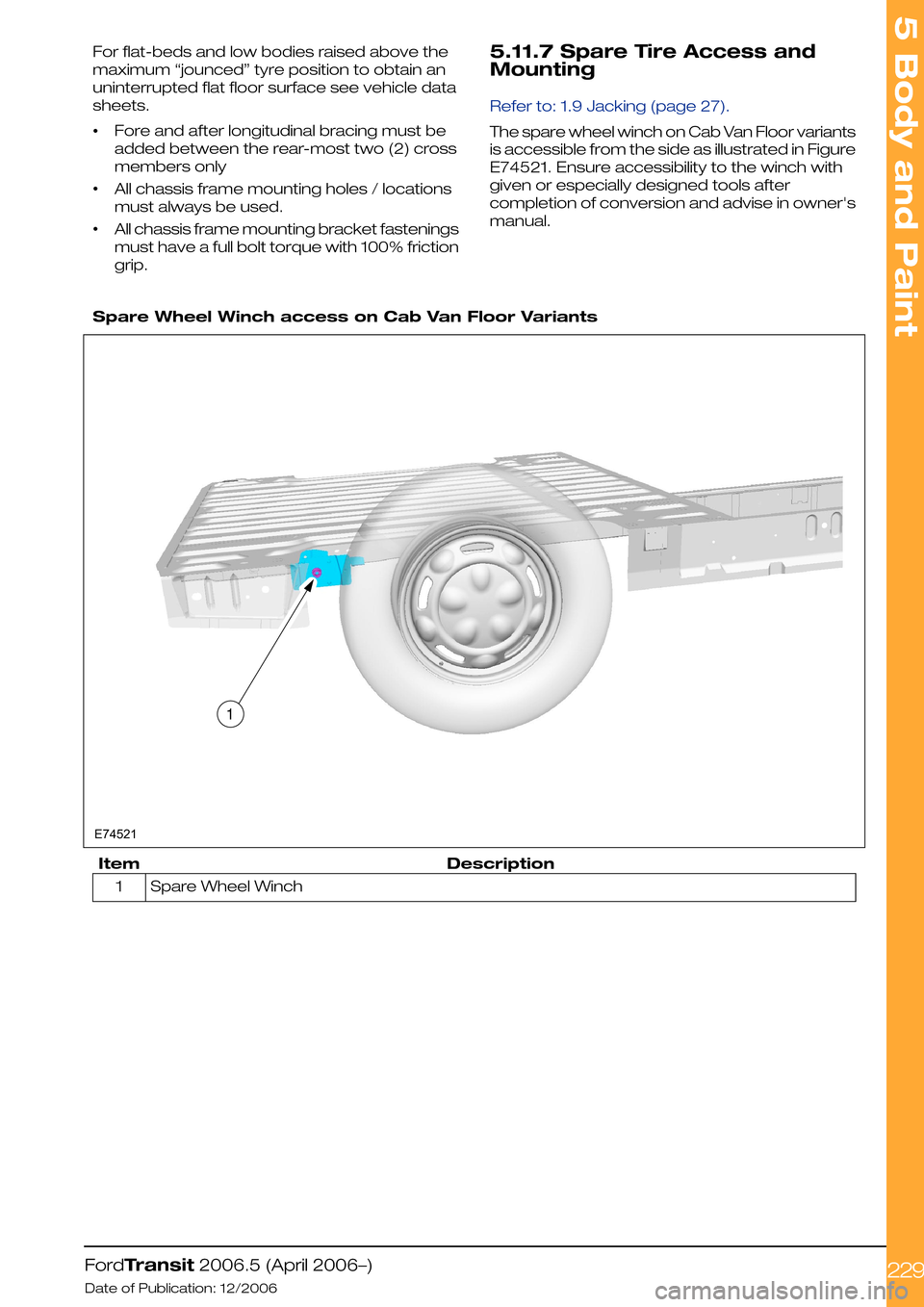
For flat-beds and low bodies raised above the
maximum “jounced” tyre position to obtain an
uninterrupted flat floor surface see vehicle data
sheets.
•Fore and after longitudinal bracing must be
added between the rear-most two (2) cross
members only
•All chassis frame mounting holes / locations
must always be used.
•All chassis frame mounting bracket fastenings
must have a full bolt torque with 100% friction
grip.
5.11.7 Spare Tire Access and
Mounting
Refer to: 1.9 Jacking (page 27).
The spare wheel winch on Cab Van Floor variants
is accessible from the side as illustrated in Figure
E74521. Ensure accessibility to the winch with
given or especially designed tools after
completion of conversion and advise in owner's
manual.
Spare Wheel Winch access on Cab Van Floor Variants
DescriptionItem
Spare Wheel Winch1
FordTransit 2006.5 (April 2006–)
Date of Publication: 12/2006
5 Body and Paint
2291E74521
Page 230 of 234
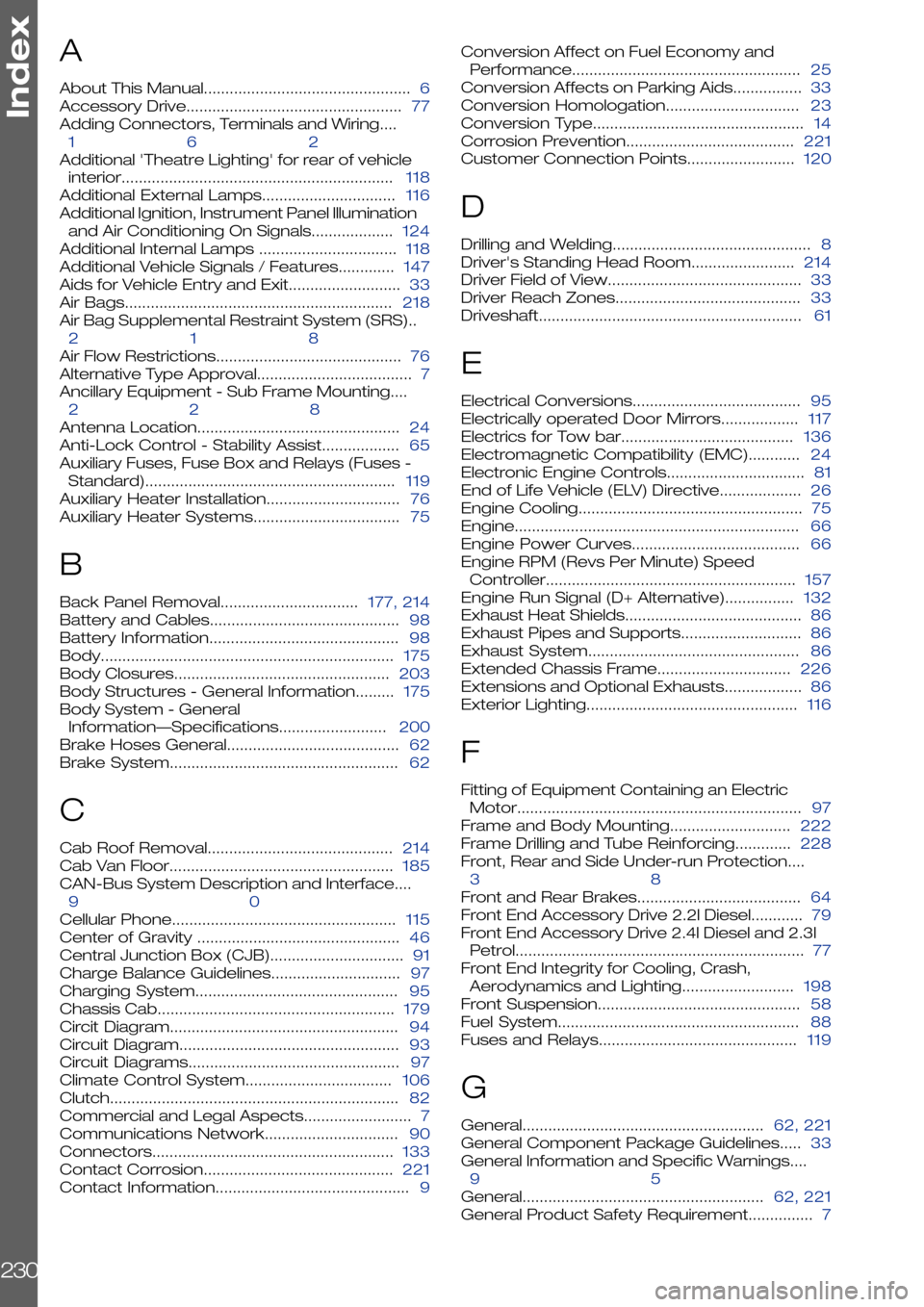
A
About This Manual................................................6
Accessory Drive..................................................77
Adding Connectors, Terminals and Wiring....
162
Additional 'Theatre Lighting' for rear of vehicle
interior...............................................................118
Additional External Lamps...............................116
Additional Ignition, Instrument Panel Illumination
and Air Conditioning On Signals...................124
Additional Internal Lamps ................................118
Additional Vehicle Signals / Features.............147
Aids for Vehicle Entry and Exit..........................33
Air Bags..............................................................218
Air Bag Supplemental Restraint System (SRS)..
218
Air Flow Restrictions...........................................76
Alternative Type Approval....................................7
Ancillary Equipment - Sub Frame Mounting....
228
Antenna Location...............................................24
Anti-Lock Control - Stability Assist..................65
Auxiliary Fuses, Fuse Box and Relays (Fuses -
Standard)..........................................................119
Auxiliary Heater Installation...............................76
Auxiliary Heater Systems..................................75
B
Back Panel Removal................................177, 214
Battery and Cables............................................98
Battery Information............................................98
Body....................................................................175
Body Closures..................................................203
Body Structures - General Information.........175
Body System - General
Information—Specifications.........................200
Brake Hoses General........................................62
Brake System.....................................................62
C
Cab Roof Removal...........................................214
Cab Van Floor....................................................185
CAN-Bus System Description and Interface....
90
Cellular Phone....................................................115
Center of Gravity ...............................................46
Central Junction Box (CJB)...............................91
Charge Balance Guidelines..............................97
Charging System...............................................95
Chassis Cab.......................................................179
Circit Diagram.....................................................94
Circuit Diagram...................................................93
Circuit Diagrams.................................................97
Climate Control System..................................106
Clutch...................................................................82
Commercial and Legal Aspects.........................7
Communications Network...............................90
Connectors........................................................133
Contact Corrosion............................................221
Contact Information.............................................9
Conversion Affect on Fuel Economy and
Performance.....................................................25
Conversion Affects on Parking Aids................33
Conversion Homologation...............................23
Conversion Type.................................................14
Corrosion Prevention.......................................221
Customer Connection Points.........................120
D
Drilling and Welding..............................................8
Driver's Standing Head Room........................214
Driver Field of View.............................................33
Driver Reach Zones...........................................33
Driveshaft.............................................................61
E
Electrical Conversions.......................................95
Electrically operated Door Mirrors..................117
Electrics for Tow bar........................................136
Electromagnetic Compatibility (EMC)............24
Electronic Engine Controls................................81
End of Life Vehicle (ELV) Directive...................26
Engine Cooling....................................................75
Engine..................................................................66
Engine Power Curves.......................................66
Engine RPM (Revs Per Minute) Speed
Controller..........................................................157
Engine Run Signal (D+ Alternative)................132
Exhaust Heat Shields.........................................86
Exhaust Pipes and Supports............................86
Exhaust System.................................................86
Extended Chassis Frame...............................226
Extensions and Optional Exhausts..................86
Exterior Lighting.................................................116
F
Fitting of Equipment Containing an Electric
Motor..................................................................97
Frame and Body Mounting............................222
Frame Drilling and Tube Reinforcing.............228
Front, Rear and Side Under-run Protection....
38
Front and Rear Brakes......................................64
Front End Accessory Drive 2.2l Diesel............79
Front End Accessory Drive 2.4l Diesel and 2.3l
Petrol...................................................................77
Front End Integrity for Cooling, Crash,
Aerodynamics and Lighting..........................198
Front Suspension...............................................58
Fuel System........................................................88
Fuses and Relays..............................................119
G
General........................................................62, 221
General Component Package Guidelines.....33
General Information and Specific Warnings....
95
General........................................................62, 221
General Product Safety Requirement...............7
Index
230